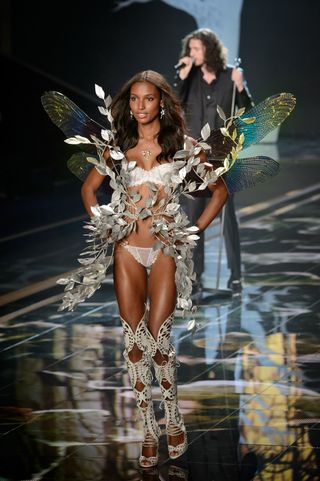Beauty
Yes, Victoria's Secret Models Are Getting Even Thinner
New research shows how the bodies of Victoria's Secret models have changed.
Posted January 25, 2020 Reviewed by Davia Sills

In 2019, Victoria’s Secret formally announced that it would no longer air its annual fashion show, in which exceptionally tall, thin, large-breasted women walked the runway sporting giant angel wings and little else. The show’s legacy lives on, though, in recent research from the Boston University School of Medicine. For researchers there, archives of the previous 24 years of Victoria’s Secret fashion shows provided a novel source of data about women’s body ideals. In a paper forthcoming in the Aesthetic Surgery Journal (published online ahead of print), these researchers provided detailed evidence that although the average U.S. woman’s body size has been increasing for decades, Victoria’s Secret models actually became thinner between 1995 and 2018.
Though much research has focused on how unattainable body ideals can promote body dissatisfaction or disordered eating in women, these researchers framed their analysis in a different way. They were interested in examining how the parameters used to evaluate the attractiveness of female bodies may have shifted over time. In particular, the authors focused on waist-to-hip ratio, an index of the extent to which a woman has an “hourglass-shaped” body with a narrow waist but wider bust and hips. Evolutionary psychologists have long argued that waist-to-hip ratio is an important indicator of female attractiveness because it is linked to health and fertility, though more recent research has called this claim into question.

The researchers at Boston University used a database called The Fashion Model Directory to find information about the bodies of the 239 models who appeared in the annual Victoria’s Secret fashion shows since 1995. The available data included hair color, eye color, height, bust size, waist size, dress size, race, and the age of the model when she first appeared in one of the runway shows. Next, the researchers compared models from the 1995-1998 shows with models from the 2015-2018 shows. Several significant differences were evident when contrasting these two groups.
First, the models got slightly younger over time. Between 2015 and 2018, the average model in these fashion shows was only 22 years old. Second, though the models were very thin to begin with, they got thinner over time. Bust, waist, and hip measurements significantly decreased between the earliest and most recent fashion shows. For example, in the 1995-1998 group, the average waist size was 24.7 inches; in the 2015-2018 group, it was a tiny 23.6 inches.
Two things remained relatively constant over the time period examined: models’ height and waist-to-hip ratios. Both the earlier and later cohort of models were tall, averaging around 5’10”. (For comparison, the average woman in the U.S. is around 5’4” tall.)
Though the size of the models’ bodies shrank over time, the hourglass shape of their bodies remained consistent. (If the bust, waist, and hips are all getting similarly smaller, the waist-to-hip ratio doesn’t change.) One limitation of the researchers’ methodology was that they were unable to obtain information about the models’ weights, having to rely on measurements instead.
Activist Jean Kilbourne, who writes about images of women in advertising, once wondered whether models could actually get any thinner. The answer from this recent analysis suggests that Victoria’s Secret, despite starting with a very thin group of fashion show models in 1995, found a way to hire even thinner models over time. Given that the average woman’s waist and dress sizes have been increasing, this means that the gap between the “ideal” woman’s body shape (at least as represented by this group of models) and the average woman’s body shape continues to grow.

On a positive note, the racial diversity of the models featured in Victoria’s Secret fashion shows did substantially increase over time. In the earliest cohort, 73 percent of the models were white; in the most recent cohort, 57 percent were white. The changes in the racial composition of Victoria’s Secret models means that, not surprisingly, hair color changed too—models were less likely to be blond in the more recent cohort.
Victoria’s Secret is still the leading lingerie brand in the U.S., but its sales have been markedly shrinking in recent years. Analyses suggest that many women have grown weary of the brand’s focus on a hypersexualized, highly unattainable female body ideal.
Instead, customers are flocking to lingerie brands that focus on comfort and inclusive sizing. Perhaps these up-and-coming brands can take the lead in offering advertising that features a more realistic array of women’s body shapes and sizes.


